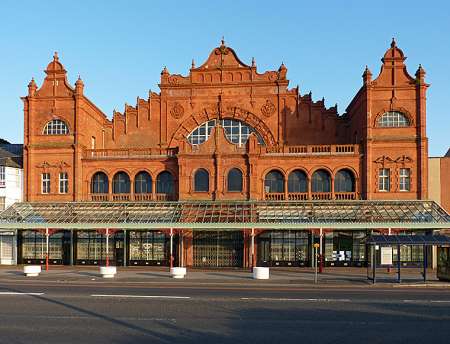Victoria Pavilion, Winter Gardens. Marine Road Central. Morecambe
In 1896 The Morecambe Winter Gardens Company Limited was formed to acquire the property known as the Winter Gardens, Marine Road, Morecambe together with the adjoining land previously the site of the baths, engine and store rooms and wooden shops all of which had been demolished and removed. It was the intention of the Company “To build upon the said land a Grand Pavilion for high-class concerts, variety and other entertainments; to furnish the same; also to build six shops facing the promenade.” Possibly as a result of their success in Blackpool, the Littlewoods were awarded the commission for this Morecambe Winter Gardens extension in the form of the Victoria Pavilion.
The new Victoria Pavilion in connection with the Winter Gardens in Morecambe was opened on Monday last. The place has been erected by Messrs S Whitehead & Sons from designs by Messrs Mangnall and Littlewood, architects, Manchester. The facade is built of terra-cotta from Ruabon and is constructed with two large balconies facing Morecambe Bay. The stage is 72 feet wide by 35 feet deep and 60 feet in height and the span of the main roof is 108 feet from wall to wall. [Building News 23 July 1897 Page 135]
VICTORIA PAVILION, MORECAMBE The new Victoria Pavilion was opened at the Winter Gardens, Morecambe on the 19th inst. The building has been erected by Messrs S Whitehead and Son of Oldham from the designs of Messrs Mangnall and Littlewoods, architects, Manchester. [Builder 24 July 1897 Page 7*]
MORECAMBE - The new Victoria Pavilion in connection with the Morecambe Winter Gardens, opened a few days ago, has been erected by Messrs. S. Whitehead and Sons, of Oldham, from the designs of Messrs. Mangnall and Littlewood, Architects, of Manchester, and the facade, which is of terra-cotta from Ruabon, is provided with two large balconies, from which a fine view is obtained of the scenery across the bay. The Pavilion, standing back as it does at a distance from the roadway, has a most striking appearance. For a place of entertainment, the span of the roof is said to be the largest in the world, measuring no less than 118 feet from wall to wall, whilst from the floor of the auditorium the roof is 65 feet high. The ceiling is covered with a very fine fibrous plastic work in the Italian Renaissance style, from the designs of Mr. Bardell (Messrs. A. R. Dean and Co., Birmingham). ‘The stage is very large, being 72ft. wide, 35ft. deep, and 60ft. to the grid floor. The entire building is illuminated by electric light, generated by the Winter Gardens Company’s own plant, the wiring and the lamps being supplied by the Keighley Electric Lighting Company. [Builders Journal 28 July 1897 page 387]
The Victoria Pavilion in connection with the Morecambe Winter Gardens, erected on the site formerly occupied by the bath, has been opened. The building has been erected by Messrs. S. Whitehead & Sons, of Oldham, from the designs of Messrs. Mangnall and Littlewood, architects, of Manchester, and the facade, which is of terra cotta from Ruabon, is provided with two large balconies, from which a fine view is obtained of the scenery across the bay. For a place of entertainment, the span of the roof is said to be the largest in the world, measuring no less than 118 feet from wall to wall, whilst from the floor of the auditorium the roof is 65 feet high. The ceiling is covered with very fine fibrous plastic work in the Italian Renaissance style, from the designs of Mr Bardell (Messrs. A. R. Dean & Co., Birmingham). The stage is very large, being 72 feet wide, 35 feet deep, and 60 feet to the grid floor. The entire building is illuminated by electric light. [British Architect 6 August 1897 page 106]
PAVILION THEATRE, MORECAMBE An addition known as the Victoria Pavilion has recently been made to the buildings in the Winter Gardens, Morecambe. The facade is built of Ruabon red terra cotta and is constructed with two large balconies from which to view the scenery of Morecambe Bay. The entrance is in faience work; the promenade which is 15 feet wide runs entirely round the auditorium. The ground floor is sloped from the back to the stage. From the entrance two flights of marble steps lead up to the first circle, where there is a smoking promenade and four tiers of seats. A second gallery to hold 1000 people is above this level. The span of the roof is 118 feet from wall to wall. This ceiling is covered with fibrous plaster-work by Dean of Birmingham. The ironwork is by the Widnes Foundry Company. The stage is 75 feet wide, 35 feet deep and 60 feet to the grid floor. The entire building is lighted by electric light, the wiring and lamps being supplied by the Keighley Electrical Lighting Company. The builders are Messrs S Whitehead and Sons, and the architects Messrs Mangnall & Littlewoods of Manchester.[Builder 7 August 1897 Page 115]
Reference Building News 23 July 1897 Page 135
Reference Builder 24 July 1897 Page 7
Reference Builders Journal 28 July 1897 page 387
Reference Builder 7 August 1897 Page 115
Reference British Architect 6 August 1897 page 106
